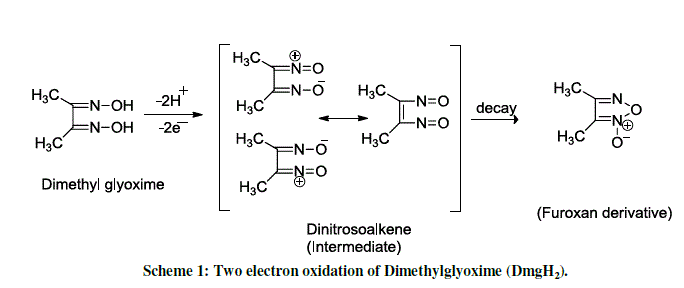ISSN ONLINE(2319-8753)PRINT(2347-6710)
ISSN ONLINE(2319-8753)PRINT(2347-6710)
Snigdha Lal1, Richa Kumari1, Sangita Katre2, Anita Kumari Gupta3, Hari Om Pandey4
|
| Related article at Pubmed, Scholar Google |
Visit for more related articles at International Journal of Innovative Research in Science, Engineering and Technology
Microwave has proved to be a convenient tool in the hands of chemists for organic synthetic processes in the recent past. In the present work, the products obtained by the oxidation of dimethylglyoxime (DmgH2) in tetrahydrofuran (THF) by ditertiary butyl chromate (TBC) in conventional and microwave dielectric heating conditions are studied. The analysis of the compounds was done by chemical as well as instrumental methods including FTIR and DTA/TGA mass loss pattern. The results clearly indicate that the reactions are much efficient, less energy and time consuming in case of microwave dielectric heating as compared to those in conventional methods
Keywords |
| Microwave, Ditertiary butyl chromate (TBC), Tertiary butyl alcohol (TBA), Dimethylglyoxime (DmgH2), Tetrahydrofuran (THF). |
I. INTRODUCTION |
| Percey Spencer in 19471 introduced microwave dielectric technique as a source of energy. In 1986, R. Gedye et.al.2, 3 applied microwave dielectric heating to organic synthesis and now there are more than 2000 papers that describe the applications of this technique for the synthesis of new compounds. Microwave Assisted Organic Synthesis (MAOS) and Microwave Induced Organic Reaction Enhancement (MORE) chemistry have gained popularity as a nonconventional eco-friendly technique for rapid organic synthesis in conformity with 12 principles of green chemistry4. P. Lidstrom et. al.5 have reported a detailed survey of MAOS and MORE.. |
| Dimethyl glyoxime is a colourless compound which is dioxime derivative of 2,3- butanedione. It is an important lab reagent used for the estimation and analysis of palladium (Pd) and nickel (Ni) .The oxidation of dimethylglyoxime gives monooxime derivative of diacetyl on alkaline oxidation with potassium persulphate in presence of copper (II) nitrate6. The formation of vic-dioxime has also been reported. The oxidation of vic-dioxime gives the dinitrosoalkene species as intermediate which decay into furoxan derivative, 3,4-dimethyl-1,2,5-oxadiazole-2-oxide7,8. |
 |
| Keeping in view, the increasing importance of MAOS and MORE in organic synthesis, the authors have undertaken the oxidation of DmgH2 in THF with ditertiary butyl chromate by microwave heating. TBC has proved to be a versatile oxidant under aqueous and non aqueous media as substantiated by the volumes of works done after its first use in 1949 by R.V. Oppenauer and H. Oberrauch9-11. The oxidation products of organic substrates formed may serve as ligands to give adducts or complexes of chromium in different oxidation states12, 13. The study of these products, M-1, M-2 and M-3, obtained by the oxidation of DmgH2 by microwave irradiation and their comparison with those obtained by conventional heating i.e. C-1, C-2 and C-3, under similar conditions, may lead to valuable generalizations as regards to the mechanism and other aspects of the reaction. |
II. MATERIAL AND METHODS |
| The chemicals used were all A.R grade. The oxidant TBC was prepared by dissolving calculated quantity of pure and dry CrO3 in tertiary butyl alcohol (TBA). The clear brown solution obtained by filtration and decantation was used as oxidant. Six samples of DmgH2 solutions in THF were prepared as per details given in table-1 and table-2. The samples M-1, M-2 and M-3 were prepared by mixing and stirring DmgH2 solution with TBC in substrate : oxidant ratio 1:2, 1:1 and 2:1 respectively followed by microwave irradiation in an LG household microwave oven MG-3937 C (MW frequency 2450 MHz). Similarly, samples C-1, C-2, and C-3 were prepared by mixing, stirring and heating the solutions in the substrate : oxidant molar ratios 1:2, 1:1 and 2:1 for the period specified in table-2. 1-2 drops of hydrazine hydrate was added to solutions as catalyst. THF was used as solvent for DmgH2 in all the cases. The samples were washed thoroughly with acetone until colourless washing and dried before collecting. |
| The samples were analyzed for chromium content volumetrically whereas carbon, hydrogen and nitrogen were estimated instrumentally by Elemental Analyzer (Heraeus Vario EL III Carlo Erba1108). The IR spectra of the samples were recorded on a Fourier Transform Infra Red Spectrophotometer Shimadzu 8201PC (4000-400 cm-1). The TG/DT analysis of the products was carried out on thermal analysis system- Perkin Elmer. The samples were heated at a rate of 10 /min. in the temperature range of 25̢̮̉ to 700̢̮̉. |
 |
III.RESULTS AND DISCUSSION |
| On the basis of facts compiled in table-1, 2 and 3, we can make many generalizations such as: |
| • As reported earlier, furoxan derivative, here also is the main oxidation product despite the fact that the medium is non-aqueous. The driving force may be the ligating ability of furoxan or the intermediate shown in scheme-1, which has electron pairs on nitrogen and oxygen atoms. |
| • Formic acid appears in the formulations only in case of 1:1 substrate is to oxidant ratio irrespective of the source of energy- conventional or microwave dielectric heating. |
| • The reaction is much efficient in microwave heating as shown in table-1 and 2. For illustration, M-1, M-2 and M-3 are formed in seconds while the formation of C-1, C-2 and C-3 takes minimum 10 minutes for the completion of the reaction. |
| • The number of water molecules in the formulations decreases as the ratio of oxidant decreases. |
| • The time required for the completion of reaction is less if the ratio of oxidant is more in both the cases i.e. conventional or microwave dielectric heating. |
| • The number of chromium atoms in the formulations decreases as the ratio of oxidant in the reaction decreases. |
| • Monoxime is not formed in the reaction as it has been observed in earlier oxidation of DmgH2 |
ACKNOWLEDGEMENTS |
| The authors are thankful to CIF, BIT, Mesra, Ranchi and Research and Development centre, Tezpur University, Assam for their cooperation in carrying out the test and analysis of samples. |
References |
|